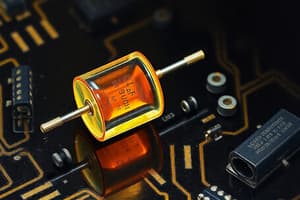Podcast
Questions and Answers
What phenomenon occurs at the atomic level in any slab in contact with flowing charge carriers?
What phenomenon occurs at the atomic level in any slab in contact with flowing charge carriers?
- Discontinuity in charge flow (correct)
- Localized electric fields
- Negligible roughness
- Continuous atomic contact
Which statement best describes the configuration of a semiconductor diode?
Which statement best describes the configuration of a semiconductor diode?
- It has three terminals, two of which are connected to an external voltage
- It operates solely on intrinsic semiconductor materials
- It consists of two p-type semiconductors bonded together
- It is a two terminal device with a p-n junction (correct)
In the context of a p-n junction diode under forward bias, where does most of the voltage drop occur?
In the context of a p-n junction diode under forward bias, where does most of the voltage drop occur?
- Across both sides equally
- In the metallic contacts
- Across the depletion region (correct)
- In the external circuit
What does the direction of the arrow in a p-n junction diode symbolize?
What does the direction of the arrow in a p-n junction diode symbolize?
What happens to the equilibrium barrier potential of a p-n junction diode when an external voltage is applied?
What happens to the equilibrium barrier potential of a p-n junction diode when an external voltage is applied?
What is the primary role of the dopant in extrinsic semiconductors?
What is the primary role of the dopant in extrinsic semiconductors?
In an n-type Si semiconductor, where is the donor energy level (ED) located?
In an n-type Si semiconductor, where is the donor energy level (ED) located?
What happens to the majority carriers when thermal minority carriers meet them?
What happens to the majority carriers when thermal minority carriers meet them?
What primarily dominates the density of holes in the valence band of a p-type semiconductor at room temperature?
What primarily dominates the density of holes in the valence band of a p-type semiconductor at room temperature?
What occurs when an electron from the valence band jumps to the acceptor energy level (EA) in a p-type semiconductor?
What occurs when an electron from the valence band jumps to the acceptor energy level (EA) in a p-type semiconductor?
Why do majority carriers help in reducing the intrinsic concentration of minority carriers?
Why do majority carriers help in reducing the intrinsic concentration of minority carriers?
How are the conduction electrons in an n-type semiconductor primarily generated?
How are the conduction electrons in an n-type semiconductor primarily generated?
What happens to holes in a p-type semiconductor at room temperature?
What happens to holes in a p-type semiconductor at room temperature?
What happens to electrons in the valence band when they gain external energy?
What happens to electrons in the valence band when they gain external energy?
At absolute zero, what characterizes the conduction band in Si and Ge?
At absolute zero, what characterizes the conduction band in Si and Ge?
What is the maximum number of electrons that can occupy the outermost orbit of Si and Ge?
What is the maximum number of electrons that can occupy the outermost orbit of Si and Ge?
What is the energy gap between the valence band and conduction band known as?
What is the energy gap between the valence band and conduction band known as?
In the context of the discussed materials, what does the term 'valence electrons' refer to?
In the context of the discussed materials, what does the term 'valence electrons' refer to?
Which of the following statements is true about the outer orbit electrons for Si and Ge?
Which of the following statements is true about the outer orbit electrons for Si and Ge?
Which statement best describes the valence band at absolute zero temperature?
Which statement best describes the valence band at absolute zero temperature?
What effect does the distance between atoms have on the energy states in a crystal?
What effect does the distance between atoms have on the energy states in a crystal?
What is the relationship between the current produced by electrons and holes in a semiconductor?
What is the relationship between the current produced by electrons and holes in a semiconductor?
At what temperature does an intrinsic semiconductor behave like an insulator?
At what temperature does an intrinsic semiconductor behave like an insulator?
What induces the excitation of electrons from the valence band to the conduction band in intrinsic semiconductors?
What induces the excitation of electrons from the valence band to the conduction band in intrinsic semiconductors?
What happens at equilibrium in a semiconductor?
What happens at equilibrium in a semiconductor?
Which of the following statements is true about recombination in semiconductors?
Which of the following statements is true about recombination in semiconductors?
What is the significance of thermally excited electrons in an intrinsic semiconductor at T > 0 K?
What is the significance of thermally excited electrons in an intrinsic semiconductor at T > 0 K?
Why does carbon behave as an insulator while silicon and germanium behave as intrinsic semiconductors?
Why does carbon behave as an insulator while silicon and germanium behave as intrinsic semiconductors?
What does the energy-band diagram of an intrinsic semiconductor show at T > 0 K?
What does the energy-band diagram of an intrinsic semiconductor show at T > 0 K?
What is the energy gap (Eg) for insulators?
What is the energy gap (Eg) for insulators?
How does a p-n junction behave in forward bias?
How does a p-n junction behave in forward bias?
What happens to electrons during conduction in a semiconductor?
What happens to electrons during conduction in a semiconductor?
What forms the depletion layer in a p-n junction?
What forms the depletion layer in a p-n junction?
In a semiconductor with low resistivity, how would the energy gap (Eg) be characterized?
In a semiconductor with low resistivity, how would the energy gap (Eg) be characterized?
What is a primary use of diodes in electronic circuits?
What is a primary use of diodes in electronic circuits?
How can the type of semiconductor be changed in compound semiconductors?
How can the type of semiconductor be changed in compound semiconductors?
What is the primary effect of applying a reverse bias to a p-n junction?
What is the primary effect of applying a reverse bias to a p-n junction?
What is the typical resistivity range for metals?
What is the typical resistivity range for metals?
What defines an intrinsic semiconductor?
What defines an intrinsic semiconductor?
In n-type semiconductors, what is the relationship between electrons and holes?
In n-type semiconductors, what is the relationship between electrons and holes?
Which type of atom is used to create n-type semiconductors?
Which type of atom is used to create n-type semiconductors?
What characterizes holes in semiconductors?
What characterizes holes in semiconductors?
Which statement is true regarding the conduction band?
Which statement is true regarding the conduction band?
What is a characteristic of p-type semiconductors?
What is a characteristic of p-type semiconductors?
Charge neutrality in a semiconductor is maintained by which of the following relationships?
Charge neutrality in a semiconductor is maintained by which of the following relationships?
Flashcards
Energy Band Gap (Eg)
Energy Band Gap (Eg)
The energy difference between the valence band (where electrons are normally located) and the conduction band (where electrons can freely move to conduct electricity).
Valence Band
Valence Band
The band of energy levels containing electrons that are tightly bound to atoms and are not free to move. Most electrons in a semiconductor reside here at absolute zero.
Conduction Band
Conduction Band
The band of energy levels above the valence band where electrons can freely move, enabling electrical conductivity.
Electrical Conduction
Electrical Conduction
Signup and view all the flashcards
Semiconductors
Semiconductors
Signup and view all the flashcards
Insulators
Insulators
Signup and view all the flashcards
Conductors
Conductors
Signup and view all the flashcards
Absolute Zero
Absolute Zero
Signup and view all the flashcards
Total Current in a Semiconductor
Total Current in a Semiconductor
Signup and view all the flashcards
Equilibrium in Semiconductors
Equilibrium in Semiconductors
Signup and view all the flashcards
Recombination in Semiconductors
Recombination in Semiconductors
Signup and view all the flashcards
Effect of Temperature on Semiconductors
Effect of Temperature on Semiconductors
Signup and view all the flashcards
Intrinsic Semiconductor at Absolute Zero
Intrinsic Semiconductor at Absolute Zero
Signup and view all the flashcards
Intrinsic Semiconductor at Temperatures Above Zero
Intrinsic Semiconductor at Temperatures Above Zero
Signup and view all the flashcards
Why is C an Insulator while Si and Ge are Semiconductors?
Why is C an Insulator while Si and Ge are Semiconductors?
Signup and view all the flashcards
Intrinsic Semiconductor
Intrinsic Semiconductor
Signup and view all the flashcards
Depletion Region
Depletion Region
Signup and view all the flashcards
Barrier Potential
Barrier Potential
Signup and view all the flashcards
p-n junction
p-n junction
Signup and view all the flashcards
Forward Bias
Forward Bias
Signup and view all the flashcards
Reverse Bias
Reverse Bias
Signup and view all the flashcards
Minority Carrier Annihilation
Minority Carrier Annihilation
Signup and view all the flashcards
Donor Energy Level (ED)
Donor Energy Level (ED)
Signup and view all the flashcards
Acceptor Energy Level (EA)
Acceptor Energy Level (EA)
Signup and view all the flashcards
Doping
Doping
Signup and view all the flashcards
n-type Semiconductor
n-type Semiconductor
Signup and view all the flashcards
p-type Semiconductor
p-type Semiconductor
Signup and view all the flashcards
Hole Formation
Hole Formation
Signup and view all the flashcards
Electrical Conductivity
Electrical Conductivity
Signup and view all the flashcards
Energy Band Gap
Energy Band Gap
Signup and view all the flashcards
Energy Gap (Eg)
Energy Gap (Eg)
Signup and view all the flashcards
Semiconductor at Absolute Zero
Semiconductor at Absolute Zero
Signup and view all the flashcards
Semiconductor at Temperatures Above Zero
Semiconductor at Temperatures Above Zero
Signup and view all the flashcards
What is a p-n junction?
What is a p-n junction?
Signup and view all the flashcards
Effect of Voltage on a p-n junction
Effect of Voltage on a p-n junction
Signup and view all the flashcards
What is a diode?
What is a diode?
Signup and view all the flashcards
How to convert AC to DC?
How to convert AC to DC?
Signup and view all the flashcards
How do compound semiconductors work?
How do compound semiconductors work?
Signup and view all the flashcards
Study Notes
Semiconductor Electronics: Materials, Devices, and Simple Circuits
- Devices control electron flow, forming electronic circuits.
- Vacuum tubes (valves), like diodes, triodes, tetrodes, and pentodes, were predecessors to transistors.
- Vacuum tubes are bulky, high-voltage, and less reliable.
- Semiconductors offer controlled charge carrier flow at low voltage and power.
- Simple stimuli (light, heat, voltage) alter semiconductor charge carrier count.
Classification of Materials
- Metals: Low resistivity, high conductivity (σ ~ 10² – 10⁸ Ω⁻¹m⁻¹).
- Semiconductors: Intermediate resistivity, intermediate conductivity (σ ~ 10⁵ – 10⁶ Ω⁻¹m⁻¹).
- Insulators: High resistivity, low conductivity (σ ~ 10⁻¹¹ – 10⁻¹⁹ Ω⁻¹m⁻¹).
- Resistivity values are indicative, not sole classification criteria.
Elemental Semiconductors
- Silicon (Si) and Germanium (Ge) are commonly used.
- These form covalent bonds in a crystal structure.
Intrinsic Semiconductors
- A pure semiconductor material.
- Charge carriers (electrons and holes) are generated due to thermal excitation.
- Number of electrons equals the number of holes (nₑ = n = nᵢ).
Extrinsic Semiconductors
- Doping pure semiconductors with impurities to improve conductivity.
- n-type: Pentavalent dopants add extra electrons (e.g., Arsenic, Antimony).
- p-type: Trivalent dopants create electron vacancies (holes) (e.g., Indium, Boron).
p-n Junction
- p-type and n-type semiconductors joined.
- Forward bias: Applied voltage opposes depletion region; large current.
- Reverse bias: Applied voltage enhances depletion region; very little current.
Studying That Suits You
Use AI to generate personalized quizzes and flashcards to suit your learning preferences.




